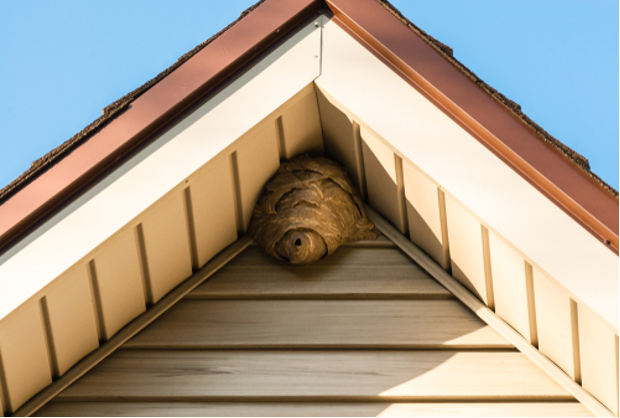When it comes to dealing with pests, especially ones that sting, safety is the number one priority. While it might be tempting to use quick DIY methods to get rid of your wasp problem, our pest control professionals at Plunkett's do not recommend doing so.
Not only is it unsafe to get rid of wasps haphazardly, it isn’t efficient. You want to get rid of the pests so they don’t come back. We hope the following guide will help you make the best decisions for your safety as well as future wasp prevention.
First thing’s first: identify the nest
Are you familiar with the appearance of a wasp nest? If not, expanding your knowledge is crucial! It is important to confirm that you’re dealing with wasps for a couple key reasons:
- Different types of insects require different types of removal techniques
- The nests of paper wasps bear a striking resemblance to certain types of bee nests that are safeguarded by the Endangered Species Act. Failure to discern a wasp nest from a bee nest could potentially lead to hefty fines.
How to Identify Different Types of Wasp Nests
1. Paper wasp nests
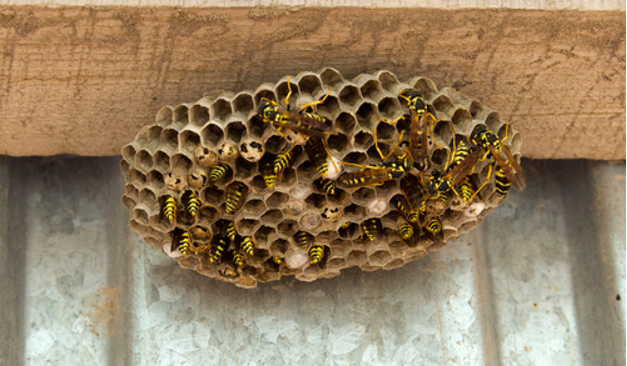
Paper wasp nests feature an open design resembling an upside-down umbrella, which exposes the hexagonal combs. They're commonly found in sheltered areas like house eaves, decks, or within hollow poles, safeguarding them from weather and predators.
Paper wasps are generally less aggressive and usually only attack if they feel threatened. Certain actions such as making quick movements near their nest could be perceived as an invasion of their territory.
Despite this, caution is advised around these creatures, as their stings can be painful. Professional pest control services are recommended for safe and effective nest removal.
2. Yellow jacket nests
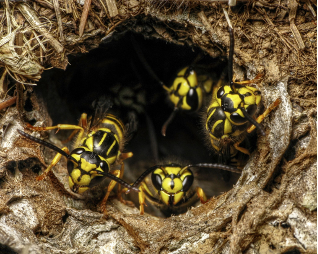
Yellow jacket nests may be free-standing or within places that provide a natural cover such as wall voids, hollow trees, or abandoned rodent burrows. These nests provide a private sanctuary for yellow jackets to live and produce.
Free-standing aerial nests exhibit a papery, encapsulated structure, quite different from the open design of paper wasp nests. They are similar in appearance to a smooth, bloated football. Void nests are usually identified by the presence of wasps leaving and entering their nesting void. Both types of nests include paper interiors similar to a paper wasp nest.
As for their temperament, yellow jackets are known for their considerable aggression. Unlike some wasp species, they have the ability to sting multiple times without losing their stinger, making them a significant threat if disturbed. Their protective instinct over their nest is strong, and they will defend it fiercely. In fact, yellow jacket nests usually have several guard wasps at the entrance of the nest. Their commitment to defending their colony is so intense that they have been known to chase potential threats or prey for distances up to a mile.
This combination of concealed nests and high aggression makes yellow jackets a particularly tricky pest to handle. Consequently, it's advisable to seek professional help for safe removal if a yellow jacket nest is discovered in your vicinity.
3. Bald-faced hornet nests
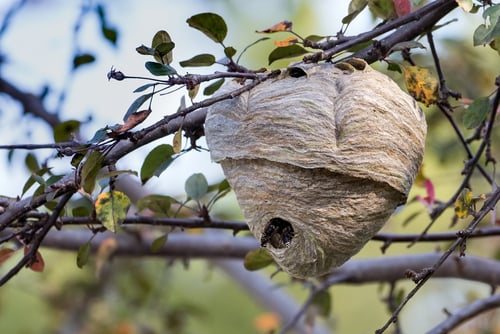
Bald-faced hornet nests are made of paper-like material and are typically located in more elevated areas.. This preference for high, out-of-reach spaces—such as tree limbs or roof eaves—helps protect the colony from predators and harsh environmental conditions.
Unlike the open construction of a paper wasp nest, a bald-faced hornet nest is fully enclosed with a single opening, making the interior invisible from the outside. The hive structure, often large and oval-shaped, resembles a swollen gray balloon with a rough, papery surface. Inside, it contains multiple tiers of hexagonal combs, similar to those seen in bee hives.
When it comes to temperament, bald-faced hornets are highly defensive. They will protect their nests with fierce aggression, more so than many other wasp species. This strong territorial instinct means that if they perceive a threat, they will not hesitate to attack.
Given the potential for multiple, painful stings, it is recommended to approach bald-faced hornet nests with extreme caution. If a nest is discovered, the best course of action is often to enlist the help of professional pest control services for safe and effective removal.
How not to remove the nest
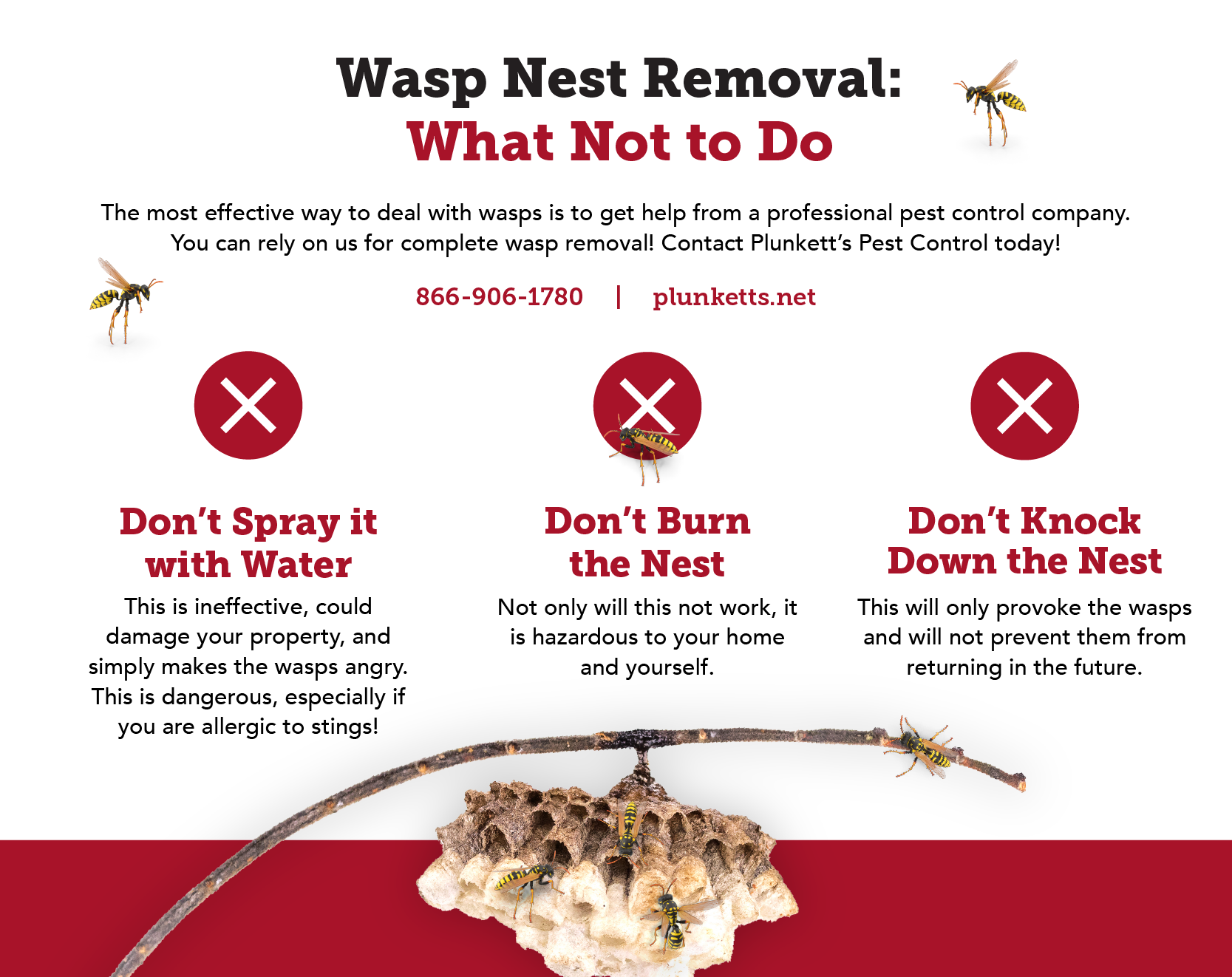
Now that you know what kind of wasp nest you’re dealing with, it’s important to know what not to do next. These are especially important to avoid if you or a family member are allergic to wasp stings. Do not:
1. Do Not Spray the Wasp Nest with Water
At first glance, using water to dislodge a wasp nest might seem like an easy solution. However, this approach is not only ineffective, but it can also put you and your property at risk. The force of water may cause physical damage to your property. Additionally, water is unlikely to eliminate the wasps. In fact, it can provoke the colony, leading to aggressive defensive behaviors. If the wasps perceive you as a threat, they may start to attack, putting you in immediate danger. Rather than resolving the issue, this method can exacerbate the problem.
2. Do Not Burn the Wasp Nest
Another misguided method is attempting to burn a wasp nest. This is not only ineffective but highly hazardous. Far from eliminating the wasp issue, the heat and flames may stimulate violent behavior in the wasps, increasing the risk of being stung. The nest material itself is extremely flammable due to its thin, papery substance. This can potentially ignite a larger fire, causing extensive damage to your property and posing a serious threat to your safety.
3. Do Not Knock Down the Nest
It might seem logical that if you can remove the nest, you can get rid of the wasp problem. However, this idea is seriously flawed. Attempting to knock down a wasp nest only serves to aggravate the wasps within, and does nothing to eliminate the colony. Once disturbed, wasps become highly defensive and are likely to attack the perceived threat, putting you in imminent danger of painful stings. This method will not prevent them from rebuilding their nest and returning to their activities because wasps leave pheromones where they build their nests and will rebuild in the same spot if all are not killed.
In all cases, professional pest control services are highly recommended for safe and effective wasp nest removal. Their knowledge and expertise ensure the situation is handled appropriately, reducing the risk to both yourself and your property.
How to Correctly Remove a Wasp Nest: Professional Pest Control
If you found a wasp nest on your property, there’s a good chance it made you feel uneasy, especially if you have young children or someone who is allergic to wasps in your family. Unfortunately, it’s not easy to remove a wasp nest yourself, so we recommend hiring a professional pest control company to do it for you. This will ensure your safety and better prevent the wasps from coming back.
At Plunkett’s, we offer efficient and safe stinging insect services that include inspection, treatment, and removal of any active nests. We will then treat the areas of concern with a residual material to greatly reduce the likelihood of nest-building. We also offer a 60-day guarantee on all nests treated!
Don’t Let Wasps Get Comfortable—Get Help from Plunkett’s!
Our expert technicians have removed thousands of wasp nests and prevented them from returning. You can count on us to get rid of these stingers for good. If you have a wasp problem on or near your property, get in touch with us right away!

